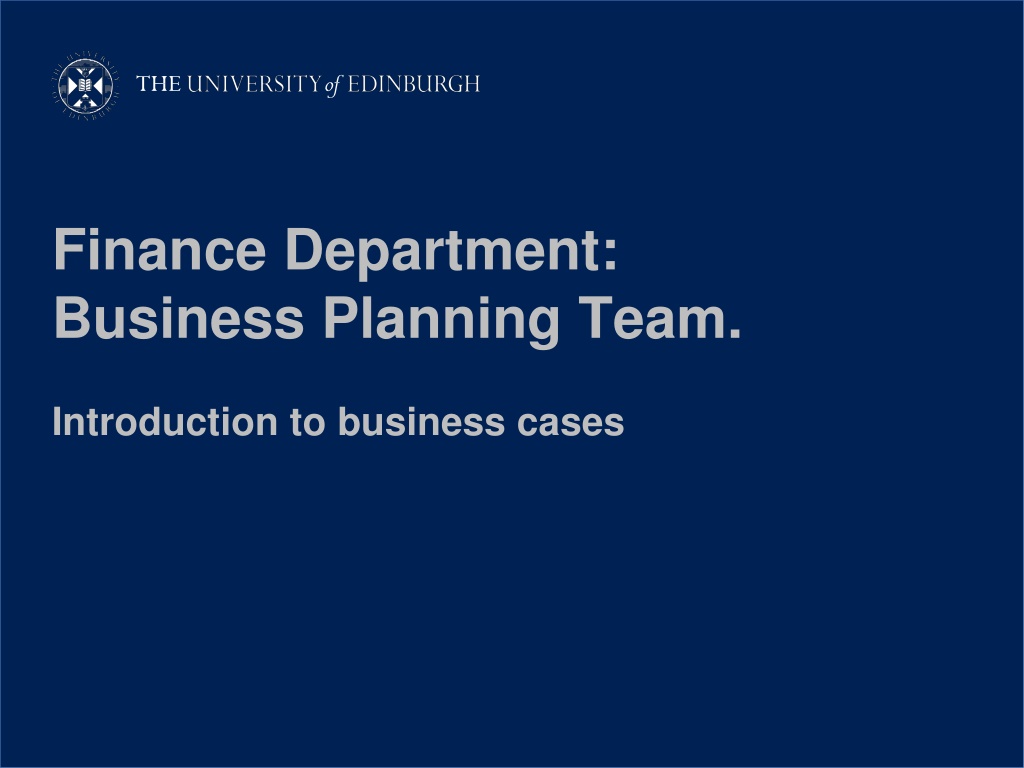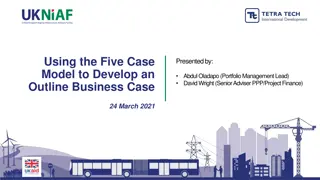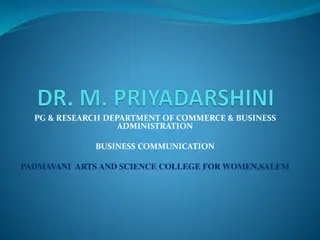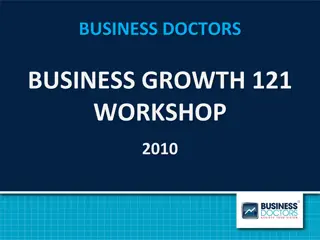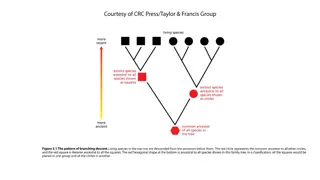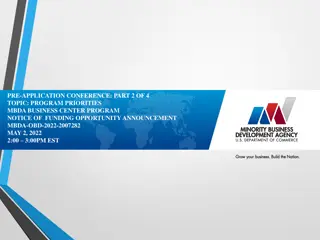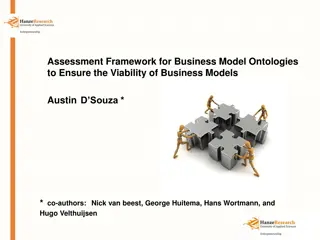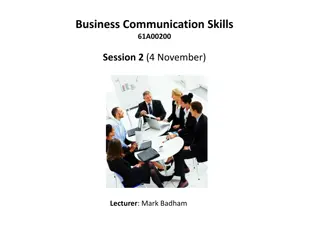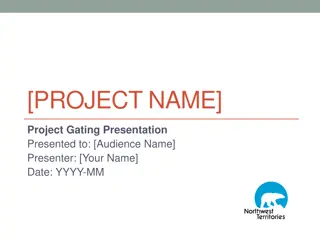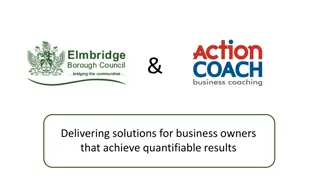Effective Business Case Development Tips
Understand the essentials of a business case for funding requests, with a focus on simplicity and clarity. Learn how to structure a compelling argument, consider multiple solutions, and make informed recommendations efficiently. Discover valuable tips to enhance your business case presentation and decision-making process.
Download Presentation

Please find below an Image/Link to download the presentation.
The content on the website is provided AS IS for your information and personal use only. It may not be sold, licensed, or shared on other websites without obtaining consent from the author. Download presentation by click this link. If you encounter any issues during the download, it is possible that the publisher has removed the file from their server.
E N D
Presentation Transcript
Finance Department: Business Planning Team. Introduction to business cases
What is a business case? It is a request for funds for an activity outside the usual planning round In later years, the activity may become business as usual (BAU). At that point it should then be funded through the planning round It needs to be a compelling argument to carry out the project
A business case does not need to be a long and complex document. Indeed, if you are requesting a relatively small amount, for a simple project, the best advice is to keep it short and to the point. As a bare minimum , a business case could be 5 paragraphs using the following headings: 1. I have identified a problem 2. The implications are as follows . 3. This is the solution I have identified 4. The solution costs this much 5. Our plan to implement it is this We refer to this as the simple skeleton of a business case. Version 2 of this is on the next slide
Version 2 of the simple skeleton is a business case- for an opportunity 1.I have identified an opportunity 2.The benefits of it are as follows . 3.The resource we need to seize the opportunity is 4.It will cost us this much 5.Our plan to implement it is this The wording is almost the same, the message is identical For a simple business case such as this, an email or word document are appropriate document types to use. Later in this document there are two example business cases available for you to see
A basic improvement to the simple skeleton You only need consider this if there are several potential solutions to the problem The reason for doing it is to demonstrate that you have considered all options and have selected the best one (which is not always the cheapest or most obvious one) We saw in earlier slides that steps 3 & 4 are 3. This is the solution I have identified 4. The solution costs this much An improvement over these would be to give an options appraisal and recommended solution. The layout would look something like this: Here s a shortlist of our options to solve the problem (include the do nothing option). A table summarising pros & cons of each, which would include their costs Your recommended option, and why It may be appropriate to include a why now paragraph, eg an upcoming legislative deadline such as GDPR, or the temporary availability of the opportunity.
Useful tip: if the options appraisal becomes lengthy, it may be better presentation to include it as an appendix at the back of the document, with a short summary in the body of the document
The simple skeleton then becomes 1.I have identified a problem 2.The implications are as follows . 3.The preferred solution to problem (and its cost) is 4.[optional]: The reason to do it now (without delay) is . 5.Our plan to implement it is this 6.Appendix: Options appraisal (pros, cons, price) Remember, you can re-word it to refer to an opportunity rather than a problem.
Secondary benefits Secondary benefits are additional benefits which your project may deliver. The primary benefit is the reason why the project is being proposed. Secondary benefits are usually not sufficient to initiate the project, but they may be a nice little extra It is possible that your business case may generate secondary benefits. Examples of these may be: Improved staff morale Environmental/Sustainability benefits Process or quality improvements. It is not compulsory to include a paragraph describing secondary benefits of your project. Some projects simply don t generate such benefits. However, if your project is likely to generate such benefits, you are advised to include a short paragraph listing the most significant 2 or 3. Do not list any more than that. Both of the sample business cases include a section for secondary benefits.
When to use the simple skeleton: When the funding required is very small, and can be paid from your own department s budget. To test the water or to seek direction from the leadership team. It can be useful as a predecessor to a longer, more detailed business case which would take significant time to prepare See the list on the next page for further guidance However, there are many circumstances when the simple skeleton is not appropriate. The next page lists the most common of those circumstances. We have a formal template for longer and more complex business cases. The Business Planning Team runs an internal training course called Writing a business case . It is bookable through MyEd. This course explains the additional steps required to complete the formal template. If you need to write a more complex business case than a simple skeleton, you should attend this course
Whether to write a simple skeleton business case or use the formal template Test Criteria Format to use Reason why Funding granted by your school s or support group s internal budget Simple Skeleton It s a small amount and a simple project, keep your business case simple. Caveat: This assumes the project doesn t do any of the complex activities listed below Funding comes from outside your school or department Formal template The formal template is standard UoE format which all requests come in You are asking for under 50k Simple Skeleton It s a small amount, keep it simple. Caveat: This assumes the project doesn t do any of the complex activities listed below Your project will recruit new staff or re-imburse volunteers Formal Template The template has a section where you must provide statements from HR and employment tax team. Show that you have incorporated their advice into your business plan. The template has a section where you must provide statements from HR, UoE s Insurance office, and employment tax team Your project has an international activity (either UoE staff overseas, or o seas staff here) Formal Template Your project will create a new legal entity (eg a company or Joint Venture) Formal Template The template has a section where you must provide statements from Legal team, Insurance team and Employment tax team, large legal entities may require approval of university court Your project will spend more than 50k with a single supplier (this includes over up to 4 years) Formal Template The template has a section where you must provide statements from Procurement team. Your project involves signing significant ongoing contracts or legal agreements Formal Template The template has a section where you must provide statements from Legal team. Such contracts may require approval of university court
Who should you present your business case to? You present your business case to the person(s) who award funding to your project. If you have used the simple skeleton format, funding should be awarded by your departmental budget. Present your business case to your school or department Finance contact. If you attend the How to write a business case course, and must use the formal template, you will be taught who to present it to.
Sample business cases A sample business case written as an email is pasted onto the next slide. For a small and simple request, (in this example it is to request centralised milk purchases for a staff team), a simple email is an appropriate method to request funds. A longer example of a simple skeleton business case (entitled Making Tax Digital ) has been prepared as a separate document. It is linked here: https://www.edweb.ed.ac.uk/files/atoms/files/sample_business_case_-_making_tax_digital.docx This business case is realistic in that the solution has to consider both an external regulatory change, and some complicating factors unique to this University. You will observe that this business case has adapted the simple skeleton to its own particular circumstances. Every project is different, so if necessary, you can and should adapt the skeleton format to tailor your business case to your particular project. We hope this document has been a useful starting point. For further information please contact the Business Planning Team, our details are on a later slide.
Example business case #1, written in an email Dear Mr X, [who is head of department] Below is the business case for centralised milk purchasing in the XYZ department: The problem This problem arises because the XYZ team is using its assets more efficiently. The asset being land within The University Building it occupies. A consequence of the recent conversion of kitchen space into meeting rooms is that there are fewer fridges for all staff to share. A large portion of the fridge space is occupied by as many as 20 one-pint bottles of milk, as each individual buys their own and writes their initials on it. Some milk is left beyond its sell by date, and there is a general reluctance to throw away other people s milk, even when it is out of date. The implications of this problem The fridges are overflowing, messy, and there isn t enough space for food. This is especially problematic on the first floor, where there are c70 staff using only 2 small under-counter fridges. Several members of staff have expressed frustration at this being a sub-optimal state of affairs. The solution The solution I propose is central purchases of one or two large bottles of milk per fridge, twice per week. This would be for all team staff to use in tea and coffee. This would remove the need for multiple individual small bottles of milk, and thus liberate space in the fridge. The plan to implement the solution The ABC dept (who occupy the floors above ours) already receive milk deliveries on Monday and Wednesday. I have found out which dairy supplies them and obtained a price list. I propose we use the same supplier and ask them to provide a separate invoice. A survey has found that 80% of milk used is green top, so to keep administration simple only green top shall be centrally provided. This should achieve the aim of reducing the volume of milk bottles in the fridges. It would be unfair to only provide milk to teams based on the first floor, so the deliveries would have to include those teams in the basement and on the ground floor. Each team has nominated a milk monitor to help administer the process, and I have collated a milk order. As time goes on, this order and this process may be adjusted once patterns of use are understood. The following points will be emphasised to all staff: All staff have a responsibility to use the milk in date order, and to be self-policing to prevent abuse of the offering This will be for an initial 1-2 month trial period If it is abused it will be withdrawn The cost of this solution. Based on the current collated order, and the price list provided, the cost is c. 13 per week. This equates to 650 per year assuming no delivery for 2 weeks at Christmas. Benefits of this solution. 1. The department continues to use its land assets efficiently and smartly, ie, there won t be a need for additional fridges to be provided. 2. Sustainability gains, as there will be a significant reduction in plastic bottles used. 3. It is a morale boost /positive signal about team staff welfare from the leadership team 4. It is an acknowledgement to staff that the kitchen / dining areas available for staff to use have been much reduced. Action required from you Please consider this request and communicate your approval or non-approval to me You will see there is an additional section showing secondary benefits. Inclusion of such a paragraph is optional. You should only include this if there are significant benefits to mention.
The Business Planning Team is here to support you as you prepare your business case(s). Our contact details: Christian Davis Finance Business Partner Tel 0131 650 6351 christian.davis@ed.ac.uk Andy Slater Finance Business Partner Tel 0131 650 4929 andy.slater@ed.ac.uk
